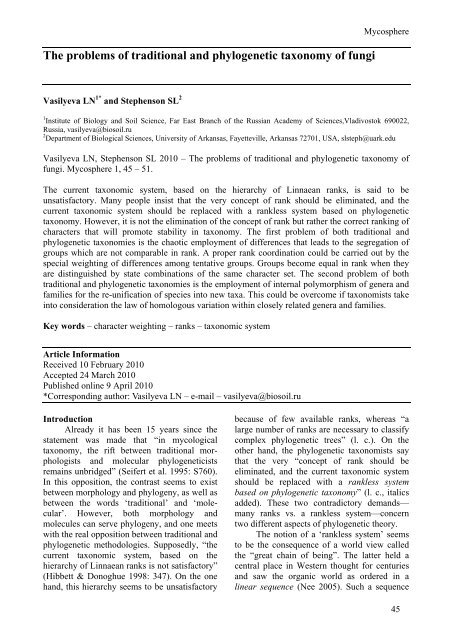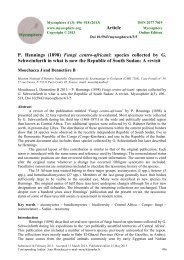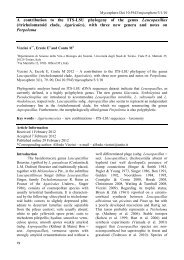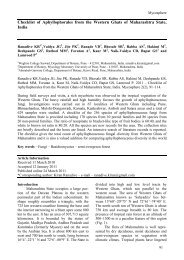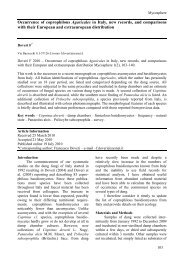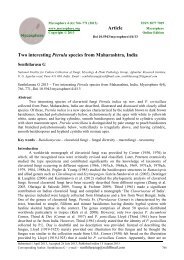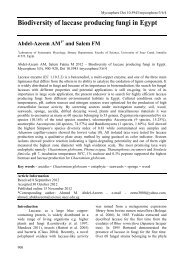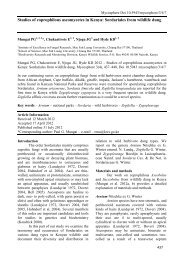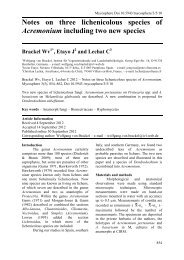The problems of traditional and phylogenetic taxonomy of fungi
The problems of traditional and phylogenetic taxonomy of fungi
The problems of traditional and phylogenetic taxonomy of fungi
Create successful ePaper yourself
Turn your PDF publications into a flip-book with our unique Google optimized e-Paper software.
<strong>The</strong> <strong>problems</strong> <strong>of</strong> <strong>traditional</strong> <strong>and</strong> <strong>phylogenetic</strong> <strong>taxonomy</strong> <strong>of</strong> <strong>fungi</strong><br />
Mycosphere<br />
Vasilyeva LN 1* <strong>and</strong> Stephenson SL 2<br />
1 Institute <strong>of</strong> Biology <strong>and</strong> Soil Science, Far East Branch <strong>of</strong> the Russian Academy <strong>of</strong> Sciences,Vladivostok 690022,<br />
Russia, vasilyeva@biosoil.ru<br />
2 Department <strong>of</strong> Biological Sciences, University <strong>of</strong> Arkansas, Fayetteville, Arkansas 72701, USA, slsteph@uark.edu<br />
Vasilyeva LN, Stephenson SL 2010 – <strong>The</strong> <strong>problems</strong> <strong>of</strong> <strong>traditional</strong> <strong>and</strong> <strong>phylogenetic</strong> <strong>taxonomy</strong> <strong>of</strong><br />
<strong>fungi</strong>. Mycosphere 1, 45 – 51.<br />
<strong>The</strong> current taxonomic system, based on the hierarchy <strong>of</strong> Linnaean ranks, is said to be<br />
unsatisfactory. Many people insist that the very concept <strong>of</strong> rank should be eliminated, <strong>and</strong> the<br />
current taxonomic system should be replaced with a rankless system based on <strong>phylogenetic</strong><br />
<strong>taxonomy</strong>. However, it is not the elimination <strong>of</strong> the concept <strong>of</strong> rank but rather the correct ranking <strong>of</strong><br />
characters that will promote stability in <strong>taxonomy</strong>. <strong>The</strong> first problem <strong>of</strong> both <strong>traditional</strong> <strong>and</strong><br />
<strong>phylogenetic</strong> taxonomies is the chaotic employment <strong>of</strong> differences that leads to the segregation <strong>of</strong><br />
groups which are not comparable in rank. A proper rank coordination could be carried out by the<br />
special weighting <strong>of</strong> differences among tentative groups. Groups become equal in rank when they<br />
are distinguished by state combinations <strong>of</strong> the same character set. <strong>The</strong> second problem <strong>of</strong> both<br />
<strong>traditional</strong> <strong>and</strong> <strong>phylogenetic</strong> taxonomies is the employment <strong>of</strong> internal polymorphism <strong>of</strong> genera <strong>and</strong><br />
families for the re-unification <strong>of</strong> species into new taxa. This could be overcome if taxonomists take<br />
into consideration the law <strong>of</strong> homologous variation within closely related genera <strong>and</strong> families.<br />
Key words – character weighting – ranks – taxonomic system<br />
Article Information<br />
Received 10 February 2010<br />
Accepted 24 March 2010<br />
Published online 9 April 2010<br />
*Corresponding author: Vasilyeva LN – e-mail – vasilyeva@biosoil.ru<br />
Introduction<br />
Already it has been 15 years since the<br />
statement was made that “in mycological<br />
<strong>taxonomy</strong>, the rift between <strong>traditional</strong> morphologists<br />
<strong>and</strong> molecular <strong>phylogenetic</strong>ists<br />
remains unbridged” (Seifert et al. 1995: S760).<br />
In this opposition, the contrast seems to exist<br />
between morphology <strong>and</strong> phylogeny, as well as<br />
between the words ‘<strong>traditional</strong>’ <strong>and</strong> ‘molecular’.<br />
However, both morphology <strong>and</strong><br />
molecules can serve phylogeny, <strong>and</strong> one meets<br />
with the real opposition between <strong>traditional</strong> <strong>and</strong><br />
<strong>phylogenetic</strong> methodologies. Supposedly, “the<br />
current taxonomic system, based on the<br />
hierarchy <strong>of</strong> Linnaean ranks is not satisfactory”<br />
(Hibbett & Donoghue 1998: 347). On the one<br />
h<strong>and</strong>, this hierarchy seems to be unsatisfactory<br />
because <strong>of</strong> few available ranks, whereas “a<br />
large number <strong>of</strong> ranks are necessary to classify<br />
complex <strong>phylogenetic</strong> trees” (l. c.). On the<br />
other h<strong>and</strong>, the <strong>phylogenetic</strong> taxonomists say<br />
that the very “concept <strong>of</strong> rank should be<br />
eliminated, <strong>and</strong> the current taxonomic system<br />
should be replaced with a rankless system<br />
based on <strong>phylogenetic</strong> <strong>taxonomy</strong>” (l. c., italics<br />
added). <strong>The</strong>se two contradictory dem<strong>and</strong>s—<br />
many ranks vs. a rankless system—concern<br />
two different aspects <strong>of</strong> <strong>phylogenetic</strong> theory.<br />
<strong>The</strong> notion <strong>of</strong> a ‘rankless system’ seems<br />
to be the consequence <strong>of</strong> a world view called<br />
the “great chain <strong>of</strong> being”. <strong>The</strong> latter held a<br />
central place in Western thought for centuries<br />
<strong>and</strong> saw the organic world as ordered in a<br />
linear sequence (Nee 2005). Such a sequence<br />
45
does not entail the appearance <strong>of</strong> ranks, but<br />
modern evolutionary views suggest a hierarchical<br />
development <strong>of</strong> the biota. “When we<br />
depict evolutionary relationships in the form <strong>of</strong><br />
a tree, we acknowledge that genealogical<br />
relationships are hierarchical by nature”<br />
(Spatafora & Blackwell 1994: 233, italics<br />
added).<br />
It should be emphasized, however, that<br />
both world views do not exclude each other.<br />
Living or extinct beings do comprise a sequence,<br />
while relationships among organisms<br />
might be hierarchical. It is currently known that<br />
the original gene pool which once existed on<br />
the Earth split into smaller pools, <strong>and</strong> they are<br />
now called Bacteria, Archaea <strong>and</strong> Eucarya<br />
(Woese 2000). <strong>The</strong> differences among them are<br />
the oldest fundamental differences that can be<br />
recognized for living organisms <strong>and</strong> have<br />
persisted from their very appearance to the<br />
present day.<br />
Later, the domain Eucarya was split into<br />
a number <strong>of</strong> kingdoms, <strong>and</strong> their differences—<br />
once again—remained to be the same during<br />
the further differentiation <strong>of</strong> Eucarya into<br />
smaller groups. While almost all animal phyla<br />
were established during the ‘Cambrian<br />
explosion’ (Marshall 2006), appearances <strong>of</strong><br />
new groups during the ‘Ordivician radiation’<br />
were manifested at lower taxonomic levels<br />
(Droser & Finnegan 2003). As a result, the<br />
organic world represents a nested hierarchy <strong>of</strong><br />
groups (Fig. 1).<br />
Thus, the same relationships exist among<br />
taxonomic groups at the same level through<br />
their evolution. <strong>The</strong>se relationships could be<br />
expressed in differences that have appeared in<br />
sequence during the differentiation <strong>of</strong> the<br />
organic world. When Linnaeus first introduced<br />
the very fruitful idea <strong>of</strong> the hierarchical<br />
ordering, he unintentionally created a taxonomic<br />
model <strong>of</strong> hierarchical evolution. <strong>The</strong><br />
Linnaean hierarchy conveys both the nesting <strong>of</strong><br />
small groups within the larger ones <strong>and</strong> the<br />
distribution <strong>of</strong> characters among levels in<br />
accordance with their appearance in time.<br />
<strong>The</strong> sequence <strong>of</strong> characters marking<br />
different levels is the only evolutionary line<br />
(‘natural scale’) in the hierarchical system, so<br />
there is no need to arrange organisms in a<br />
‘chain <strong>of</strong> beings’ (i.e. the construction <strong>of</strong><br />
system does not require the tracing <strong>of</strong> ancestors<br />
<strong>and</strong> descendants). If one could establish the<br />
sequence <strong>of</strong> characters correctly, one would<br />
find the only structure that retains stability in<br />
the continuing process <strong>of</strong> change. <strong>The</strong>reby, one<br />
would come to the most natural system<br />
reflecting the hierarchical evolution.<br />
<strong>The</strong>refore, it is not the elimination <strong>of</strong> the<br />
very concept <strong>of</strong> rank that “promotes<br />
nomenclatural stability” (Hibbett & Donoghue<br />
1998: 347) but rather it is the proper ranking <strong>of</strong><br />
characters for the groups being considered.<br />
<strong>The</strong> problem <strong>of</strong> ranking is the gist <strong>of</strong> <strong>taxonomy</strong>,<br />
although both <strong>traditional</strong> <strong>and</strong> <strong>phylogenetic</strong><br />
<strong>taxonomy</strong> seem to have failed in resolving this<br />
problem. It is true that the current taxonomic<br />
system is not satisfactory, but this is not<br />
because it is based on the hierarchy <strong>of</strong><br />
Linnaean ranks. Instead, the situation exists<br />
because there was no method for finding the<br />
place <strong>of</strong> a character in the hierarchy.<br />
Even if taxonomists could have a kind <strong>of</strong><br />
a ‘rough’ hierarchy on the basis that some<br />
characters cover more extensive groups than<br />
others, the choice <strong>of</strong> characters for group<br />
delimitation at each level is <strong>of</strong>ten haphazard.<br />
<strong>The</strong> chaotic employment <strong>of</strong> any ‘unique<br />
character’ leads to groups that are similar to<br />
ones in the ancient Chinese encyclopedia<br />
described by the famous Argentine writer Jorge<br />
Luis Borges. In that encyclopedia, animals<br />
were divided into many groups, including such<br />
examples as (1) belonging to the emperor, (2)<br />
embalmed, (3) fabulous, (4) stray dogs, (5)<br />
suckling pigs, (6) those that look like flies from<br />
a long way <strong>of</strong>f, <strong>and</strong> so on.<br />
Such a ‘classification’ is quite compatible<br />
with the practice <strong>of</strong> constructing a key<br />
for the identification <strong>of</strong> groups assigned to the<br />
same level (species, genera, or families). For<br />
example, the delimitation <strong>of</strong> genera in the<br />
family Capnodiaceae (Capnodiales, Ascomycota)<br />
goes as follows: Trichomerium differs<br />
from all other genera in having sessile fruit<br />
bodies, Scorias is characterized by a ‘stromatal<br />
habit’ <strong>of</strong> those fruit bodies, Capnodium<br />
possesses pigmented ascospores, Limacinula is<br />
based on the presence <strong>of</strong> thin-walled hyphae<br />
below the ascomata, while Trichopeltheca has<br />
no periphysoids (Reynolds 1986).<br />
<strong>The</strong> dichotomous key for these genera is<br />
similar to a cladogram <strong>and</strong> is considered to<br />
represent ‘<strong>phylogenetic</strong> relationships’. In fact,<br />
46
Mycosphere<br />
Fig. 1. <strong>The</strong> organic world depicted as a nested hierarchy <strong>of</strong> groups.<br />
the first problem shared by <strong>traditional</strong> <strong>and</strong><br />
<strong>phylogenetic</strong> <strong>taxonomy</strong> is the ‘principle <strong>of</strong><br />
dichotomy’. <strong>The</strong> first hierarchical dichotomy<br />
could be found in Plato's dialogue Sophiste,<br />
although its invention is attributed to the<br />
neoplatonic philosopher Porphyry. <strong>The</strong> famous<br />
‘Porphyrian tree’ is known to be a tree-like<br />
construction where points <strong>of</strong> branching are<br />
marked by the differences <strong>of</strong> successively<br />
smaller groups. However many dichotomies do<br />
not convey hierarchical relationships at all.<br />
<strong>The</strong> keys <strong>of</strong> <strong>traditional</strong> <strong>taxonomy</strong> that are<br />
based on chaotic employment <strong>of</strong> ‘unique’<br />
character states for the segregation <strong>of</strong> species<br />
or genera are clearly artificial but they, at least,<br />
do not aim at the ‘phylogeny reconstruction’. It<br />
is worse that <strong>phylogenetic</strong> <strong>taxonomy</strong>—using<br />
precisely the same approach to characters—<br />
proclaims that a ‘dichotomy principle’ is the<br />
only one which should be used to show the real<br />
<strong>and</strong> hierarchical relationships. This is why each<br />
point <strong>of</strong> branching in a cladogram is <strong>of</strong>ten<br />
considered to correspond to a different level <strong>of</strong><br />
hierarchy <strong>and</strong> also why <strong>phylogenetic</strong>ists<br />
require “a large number <strong>of</strong> ranks… to classify<br />
complex <strong>phylogenetic</strong> trees” (Hibbett &<br />
Donoghue 1998: 347).<br />
One can underst<strong>and</strong> the key-like <strong>and</strong><br />
artificial nature <strong>of</strong> many ‘<strong>phylogenetic</strong> trees’<br />
from the statement that “over 12,000 equally<br />
parsimonious trees are possible for the 142<br />
taxa” (Parmasto 1995: S843). Evidently,<br />
12,000 different keys could be constructed,<br />
depending upon the choice <strong>of</strong> the first taxon<br />
which is pared <strong>of</strong>f from all <strong>of</strong> the others, but<br />
the true hierarchy <strong>of</strong> characters should be a<br />
single one.<br />
In the true hierarchy, many characters are<br />
equal in level, <strong>and</strong> our task is to find such<br />
character complexes. In his discussion <strong>of</strong><br />
molecular characters <strong>and</strong> their significance for<br />
fungal systematics Hibbett (1992: 534) was<br />
quite right in stating that “molecular characters,<br />
though informative in many cases, are not the<br />
47
‘Rosetta stone’ <strong>of</strong> systematics”; in fact, they<br />
are subject to many <strong>of</strong> the same <strong>problems</strong> as<br />
morphological characters, <strong>and</strong> “the characters<br />
themselves are only as good as the method <strong>of</strong><br />
analysis”. In the section that follows, the<br />
method <strong>of</strong> analysis aiming at the testing taxa<br />
for rank equality will be discussed.<br />
First, this method does not allow us to<br />
employ chaotic differences for the segregation<br />
<strong>of</strong> taxa <strong>of</strong> equal rank. It is based on the very old<br />
rule discussed already by Linnaeus, who used<br />
such words as ‘unique idea’ for a set <strong>of</strong><br />
characters distinguishing genera in the natural<br />
order (Philosophia Botanica-187). That was his<br />
way <strong>of</strong> saying that taxonomic groups are<br />
comparable in level, or rank, only when they<br />
are defined by state combinations <strong>of</strong> the same<br />
character set. When this rule is applied in<br />
practice, taxa <strong>of</strong> the same level are usually<br />
arranged in the combinatorial—multidimensional<br />
- space <strong>of</strong> character states (Vasilyeva<br />
1999).<br />
One should not take any characters with<br />
states combining with each other. One should<br />
weight delimitative characters in accordance<br />
with the frequency <strong>of</strong> their participation in<br />
delimitation. When a taxonomist begins to<br />
study, for example, a family, he or she wants to<br />
know all genera that were placed into that<br />
family but cannot always estimate the<br />
differences between them properly. A good<br />
example is the family Gnomoniaceae (Diaporthales,<br />
Ascomycota). Different authors have<br />
assigned about 40 genera to this family <strong>and</strong><br />
have made use <strong>of</strong> a number <strong>of</strong> distinguishing<br />
characters.<br />
<strong>The</strong> most frequently used distinguishing<br />
character was the kind <strong>of</strong> spores, which<br />
delimits Gnomoniella (amerospores) Apiognomonia<br />
(apiospores), Gnomonia (didymospores)<br />
<strong>and</strong> Ophiognomonia (scolecospores) (Fig. 2).<br />
A second character <strong>of</strong>ten used for distinguishing<br />
genera in this family is the position<br />
<strong>of</strong> the elongated perithecial beak—it may be<br />
central or lateral as in Apiognomonia <strong>and</strong><br />
Apioplagiostoma, Gnomonia <strong>and</strong> Plagiostoma,<br />
Ophiognomonia <strong>and</strong> Pleuroceras.<br />
A third character used most frequently to<br />
describe new genera in this family is the kind<br />
<strong>of</strong> fruit body. <strong>The</strong> latter could be simple<br />
without any stromatic development, or such a<br />
stromatic development is present <strong>and</strong> referred<br />
to as a clypeus. <strong>The</strong> presence or absence <strong>of</strong> a<br />
clypeus distinguishes Gnomoniella <strong>and</strong><br />
Mazzantia, Gnomonia <strong>and</strong> Melanopelta,<br />
Apioplagiostoma <strong>and</strong> Hypospilina, Pleuroceras<br />
<strong>and</strong> Linospora. <strong>The</strong> further development <strong>of</strong><br />
stromatic tissue leads to the appearance <strong>of</strong> a<br />
stromatic capsule that surrounds the fruit body.<br />
Moreover, this kind <strong>of</strong> fruit body combines<br />
with different kinds <strong>of</strong> spores, as is the case for<br />
Mamianiella (amerospores) <strong>and</strong> Mamiania<br />
(apiospores).<br />
<strong>The</strong> Gnomoniaceae in two monographs<br />
(Barr 1978, Monod 1983) also includes the<br />
genus Plagiosphaera, which shares its place<br />
with Pleuroceras by having the same state<br />
combination <strong>of</strong> characters in question. One<br />
treatment (Barr 1978) distinguishes these<br />
genera on the basis that members <strong>of</strong><br />
Pleuroceras occur on dead leaves <strong>of</strong> deciduous<br />
trees, whereas members <strong>of</strong> Plagiosphaera<br />
occur on herbaceous stalks. Such a difference<br />
does not allow us to consider these two taxa as<br />
separate genera, since many closely related<br />
genera, such as Plagiostoma, Gnomonia or<br />
Gnomoniella include members that occur both<br />
on leaves <strong>of</strong> trees <strong>and</strong> herbaceous stalks. As<br />
such, this character displays variability inside<br />
genera (element <strong>of</strong> the internal polymorphism)<br />
in this group <strong>and</strong> cannot be used to divide some<br />
other genera.<br />
In the other treatment (Monod 1983), one<br />
can see that Ophiognomonia <strong>and</strong> Pleuroceras<br />
are distinguished from Plagiosphaera because<br />
these two genera lack paraphyses, as do all<br />
other members <strong>of</strong> the Gnomoniaceae. In such a<br />
case, Plagiosphaera should belong to a<br />
different order, since the presence or absence<br />
<strong>of</strong> paraphyses is <strong>of</strong> value at that high level. <strong>The</strong><br />
removal <strong>of</strong> Plagiosphaera from the Gnomoniaceae<br />
would increase both the naturalness <strong>of</strong><br />
the family composition <strong>and</strong> the naturalness <strong>of</strong><br />
character hierarchy, since one false ‘generic’<br />
character (occurrences on the leaves <strong>of</strong><br />
deciduous trees or herbaceous stalks) became<br />
lower in level, whereas another character<br />
(presence or absence <strong>of</strong> paraphyses) used for<br />
genera delimitation appears to be higher in<br />
level.<br />
A similar investigation <strong>of</strong> other situations<br />
in which two or more genera fall in the same<br />
place in accordance with the distribution along<br />
the most frequent delimitative characters<br />
48
Mycosphere<br />
Fig. 2. Characters that have been used to distinguish different genera in the family Gnomoniaceae.<br />
allows us to go further in making the existing<br />
system more natural without eliminating the<br />
Linnaean ranks. Moreover, in addition to<br />
containing groups that are ranked properly in<br />
relation to each other, the natural system<br />
should be highly prognostic (de Hoog 1981).<br />
Evidently, the empty places at each level<br />
can predict the possible—living, fossil,<br />
forthcoming, or yet unfound—organisms with<br />
certain character state combinations. Some<br />
expected combinations in the family Gnomoniaceae<br />
really do exist, but - without the<br />
method <strong>of</strong> a posteriori estimation <strong>of</strong> delimitative<br />
characters - these combinations are<br />
buried in wrong places. Thus, the genus<br />
Chalcosphaeria (didymospores + clypeus +<br />
lateral perithecial beaks) was described almost<br />
a century ago, but its name was reduced to<br />
synonyms <strong>of</strong> either Plagiostoma (Barr 1978) or<br />
Hypospilina (Monod 1983). Another example<br />
is Mamiania alni (didymospores + central<br />
beaks + stromatic capsule), which might<br />
deserve its own genus that is not yet described.<br />
It might seem curious that the<br />
improvement <strong>of</strong> a character hierarchy is carried<br />
out with the help <strong>of</strong> combinatorial constructions.<br />
Some authors consider such<br />
constructions as a special kind <strong>of</strong> a system that<br />
has a reticulate structure (de Hoog 1979) in<br />
opposition to a hierarchical system. However,<br />
the opposition is imaginary, since reticulations<br />
are particular phenomena at different levels <strong>of</strong><br />
the hierarchy. What does really make a contrast<br />
is reticulate versus dichotomous arrangement<br />
<strong>of</strong> groups at the same level.<br />
Since dichotomous constructions do not<br />
convey real <strong>phylogenetic</strong> relationships among<br />
groups <strong>of</strong> the same rank (see above), how<br />
might these groups originate <strong>The</strong>re is no need<br />
to talk about a special 'reticulate evolution',<br />
since they appear as the result <strong>of</strong> Darwinian<br />
‘indefinite’ variation, which simply means that<br />
any character <strong>of</strong> an organism can change in a<br />
good or bad direction.<br />
One can turn to a large group, for<br />
example a genus containing numerous species,<br />
<strong>and</strong> expect that one <strong>of</strong> the species combinations<br />
might be ancestral to some others. <strong>The</strong> species<br />
that differs from many others at least in one<br />
character is the most suitable c<strong>and</strong>idate for an<br />
ancestor, <strong>and</strong> one can designate some <strong>of</strong> its<br />
characters by capital letters (ABCD). All <strong>of</strong><br />
these characters can change simultaneously but<br />
in different descendants, <strong>and</strong> one can find<br />
descendant combinations such as aBCD, AbCD,<br />
ABcD, ABCd.<br />
49
Now, if only one character changes in<br />
each case, any descendant shares with an<br />
ancestor almost the same genetic program <strong>and</strong><br />
the ability to change in the same directions.<br />
<strong>The</strong>refore, already the third generation <strong>of</strong><br />
descendants might represent more diverse<br />
combinations (i.e., abCD, abcD, aBCd, AbcD,<br />
AbCd, ABcd, etc.). After all, a combination<br />
consisting <strong>of</strong> completely apomorphic states<br />
(abcd) might originate, <strong>and</strong> the combinatorial<br />
space constructed with the help <strong>of</strong> four<br />
changing characters will be completed with<br />
groups <strong>of</strong> the same level.<br />
One should take into account that every<br />
such diversification includes one group that is<br />
characterized only by plesiomorphies <strong>and</strong> one<br />
group that possesses exclusively apomorphies.<br />
Character states <strong>of</strong> all other groups are<br />
mixtures <strong>of</strong> apomorphies <strong>and</strong> plesiomorphies in<br />
different proportions. This makes the second<br />
principle <strong>of</strong> <strong>phylogenetic</strong> theory, namely the<br />
‘principle <strong>of</strong> synapomophy’, invalid. Similar to<br />
the ‘dichotomy principle’, it merely creates<br />
heterogeneous groups <strong>and</strong> increases the<br />
artificiality <strong>of</strong> systems.<br />
Except for cases in which synapomorphies<br />
are states <strong>of</strong> delimitative characters,<br />
they might occur in the internal polymorphism<br />
<strong>of</strong> closely related taxa. It is very important to<br />
keep in mind the extent to which such<br />
polymorphism can exist. For example, the two<br />
genera Gnomonia <strong>and</strong> Plagiostoma differ in the<br />
position <strong>of</strong> the perithecial beak (central or<br />
lateral) <strong>and</strong> are placed in different families by<br />
those authors who overestimate the level <strong>of</strong> this<br />
character (Barr 1978; Lumbsch & Huhndorf<br />
2007). However, these genera have exactly the<br />
same internal polymorphism (i.e. repetitive<br />
characters that distinguish species within them).<br />
Those repetitive characters are the basis<br />
<strong>of</strong> the law <strong>of</strong> homologous variation (Vavilov<br />
1922), which tells us that the more complete<br />
the series <strong>of</strong> repetitive characters in two genera<br />
(or families), the more closely related these<br />
genera (or families) are. <strong>The</strong>refore, the position<br />
<strong>of</strong> Gnomonia <strong>and</strong> Plagiostoma within the same<br />
family is supported by their similar internal<br />
polymorphism. Unfortunately, the “<strong>phylogenetic</strong>”<br />
approach is known for two blunders when<br />
that polymorphism is concerned.<br />
What is it that <strong>phylogenetic</strong>ists really do<br />
<strong>The</strong>y take species, for example from the genera<br />
Gnomonia <strong>and</strong> Plagiostoma, <strong>and</strong> involve them<br />
in <strong>phylogenetic</strong> analysis. <strong>The</strong> same features <strong>of</strong><br />
these species could be apomorphic <strong>and</strong><br />
plesiomorphic—at the species level—within<br />
both genera, but the employment <strong>of</strong> the<br />
‘synapomophy principle’ will unite<br />
‘apomorphic species’ from two genera into a<br />
new heterogeneous group. <strong>The</strong>reby,<br />
<strong>phylogenetic</strong>ists make a change at the generic<br />
level by using species characters. <strong>The</strong>re are<br />
even some drastic changes at much higher<br />
levels—one can look at the treatment <strong>of</strong><br />
erysiphaceous <strong>fungi</strong> among the leotioid<br />
discomycetes (Lutzoni et al. 2004: 1457).<br />
<strong>The</strong> second blunder <strong>of</strong> the <strong>phylogenetic</strong><br />
approach is associated with the fact that<br />
characters <strong>of</strong> internal polymorphism always<br />
outnumber the few differences that exist<br />
between closely related genera or families. In<br />
molecular <strong>taxonomy</strong>, which provides many<br />
more characters than morphology, the<br />
characters <strong>of</strong> internal polymorphism become an<br />
overwhelming majority. Of course, species <strong>of</strong><br />
many genera <strong>of</strong> the family Gnomoniaceae (<strong>and</strong><br />
even the whole order Diaporthales) could<br />
appear near each other on a ‘molecular tree’<br />
(Castlebury et al. 2002). <strong>The</strong>re is nothing<br />
‘<strong>phylogenetic</strong>’ in such an approach; it is a<br />
purely 'numerical' <strong>taxonomy</strong> which makes<br />
unifications on the basis <strong>of</strong> 'overall similarity'<br />
<strong>and</strong> even does not envisage the testing <strong>of</strong><br />
tentative groups by weighting their delimitative<br />
characters.<br />
References<br />
Barr ME 1978 – <strong>The</strong> Diaporthales in North<br />
America with emphasis on Gnomonia<br />
<strong>and</strong> its segregates. Mycologia Memoir 7,<br />
1–232.<br />
Castlebury LA, Rossman AY, Jaklitsch W,<br />
Vasilyeva LN 2002 – A preliminary<br />
overview <strong>of</strong> the Diaporthales based on<br />
large subunit nuclear ribosomal DNA.<br />
Mycologia 94, 1017–1031.<br />
Droser ML, Finnegan S 2003 – <strong>The</strong> Ordovician<br />
Radiation: a follow-up to the Cambrian<br />
explosion Integrative <strong>and</strong> Comparative<br />
Biology 43, 178–184.<br />
50
Mycosphere<br />
Hibbett DS 1992 – Ribosomal RNA <strong>and</strong> fungal<br />
systematics. Transactions <strong>of</strong> the Mycological<br />
Society <strong>of</strong> Japan 33, 533–556.<br />
Hibbett DS, Donoghue MJ 1998 – Integrating<br />
<strong>phylogenetic</strong> analysis <strong>and</strong> classification<br />
in <strong>fungi</strong>. Mycologia 90, 347–356.<br />
Hoog GS de 1979 – Deductive classification—<br />
worked examples using anamorph <strong>and</strong><br />
teleomorph data in the Ascomycetes. In:<br />
<strong>The</strong> whole fungus. Vol. 1. (ed B<br />
Kendrick). Ottawa: National Museum <strong>of</strong><br />
Canada, 215–239.<br />
Hoog GS de 1981 – Methodology <strong>of</strong> <strong>taxonomy</strong>.<br />
Taxon 30, 779–783.<br />
Lumbsch T, Huhndorf SM. 2007 – Outline <strong>of</strong><br />
Ascomycota - 2007. Myconet 13, 1–58.<br />
Lutzoni F, et al. 2004 – Assembling the fungal<br />
tree <strong>of</strong> life: progress, classification, <strong>and</strong><br />
evolution <strong>of</strong> subcellular traits. American<br />
Journal <strong>of</strong> Botany 91, 1446–1480.<br />
Marshall CR 2006. Explaining the Cambrian<br />
“explosion” <strong>of</strong> animals. Annual Review<br />
<strong>of</strong> Earth <strong>and</strong> Planetary Sciences 34, 355–<br />
384.<br />
Monod M 1983 – Monographie taxonomique<br />
des Gnomoniaceae. Beiheft zur Sydowia<br />
9, 1–315.<br />
Nee S 2005 – <strong>The</strong> great chain <strong>of</strong> being. Nature<br />
435, 429.<br />
Parmasto E 1995 – Corticioid <strong>fungi</strong>: a cladistic<br />
study <strong>of</strong> a paraphyletic group. Canadian<br />
Journal <strong>of</strong> Botany 73(Suppl.), S843–<br />
S852.<br />
Reynolds DR 1986 – Foliicolous ascomycetes.<br />
7. Phylogenetic systematics <strong>of</strong> the<br />
Capnodiaceae. Mycotaxon 27, 377–403.<br />
Seifert KA, Wingfield BD, Wingfield MJ 1995<br />
– A critique <strong>of</strong> DNA sequence analysis in<br />
the <strong>taxonomy</strong> <strong>of</strong> filamentous Ascomycetes<br />
<strong>and</strong> ascomycetous anamorphs.<br />
Canadian Journal <strong>of</strong> Botany 73(Suppl.),<br />
S760–S767.<br />
Spatafora JW, Blackwell M 1994 – Cladistic<br />
analysis <strong>of</strong> partial 35rDNA sequences<br />
among unitunicate perithecial Ascomycetes<br />
<strong>and</strong> its implications on the<br />
evolution <strong>of</strong> centrum development.<br />
Ascomycete systematics (ed. DL<br />
Hawksworth). New York & London,<br />
233–242.<br />
Vasilyeva LN 1999 – Systematics in mycology.<br />
Bibliotheca Mycologica 178, 1–253.<br />
Vavilov NI 1922 – <strong>The</strong> law <strong>of</strong> homological<br />
series in variation. Journal <strong>of</strong> Genetics 12,<br />
47–89.<br />
Woese CR 2000 – Interpreting the universal<br />
<strong>phylogenetic</strong> tree. Proceedings <strong>of</strong> the<br />
National Academy <strong>of</strong> Sciences <strong>of</strong> the<br />
USA 97, 8392–8396<br />
51


